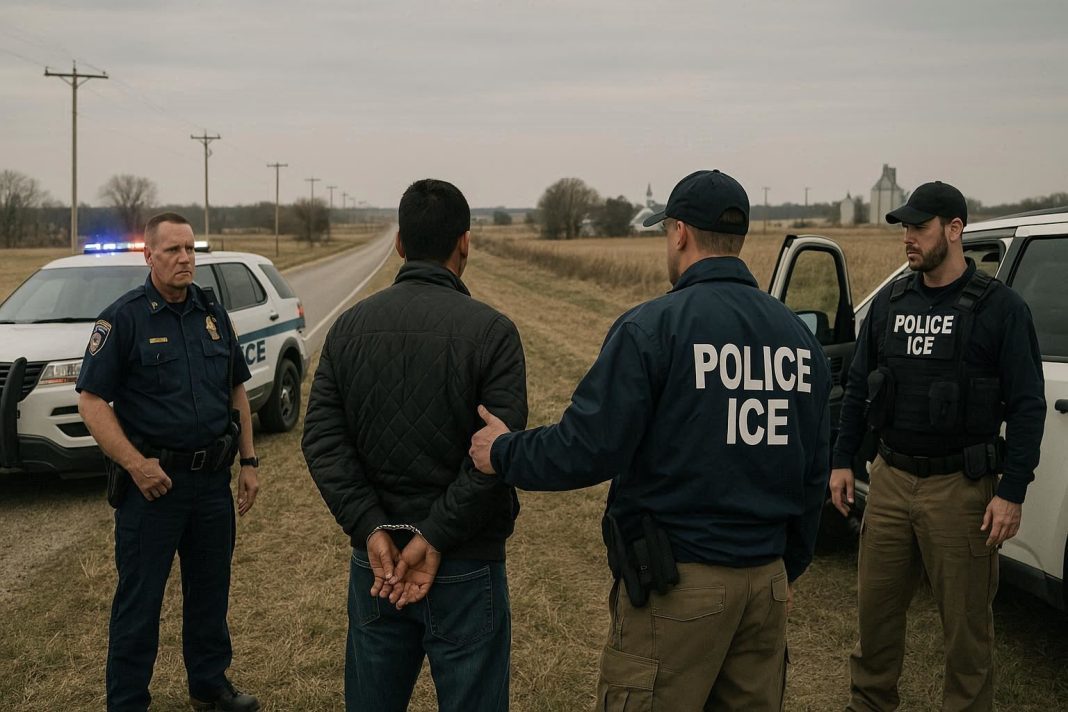The ICE 287(g) program is growing quickly across the Midwest, and immigration advocates say oversight is lacking. The Department of Homeland Security (DHS) recently introduced new financial incentives to encourage more local law enforcement participation in ICE partnerships.
Since President Donald Trump began his second term, agreements allowing local agencies to assist ICE have surged dramatically. In January 2025, there were 135 agreements nationwide. By September, that number had jumped to over 1,000.
Midwest Sees Rapid Growth in ICE Partnerships
The 287(g) program allows local officers to work with ICE under three models. In the jail enforcement model, officers can question individuals about immigration status in jails. The warrant service model allows officers to serve ICE warrants, while the task force model permits officers to make immigration-related arrests. Local agencies pay the costs of participating, including salaries and overtime, in exchange for ICE training and limited enforcement powers. Soon, financial incentives from DHS could further boost ICE partnerships.
In Iowa, Kansas, Missouri, and Nebraska, agreements have increased sharply. By September 18, 2025, 34 agreements were active in these states, compared to just three in January. At least three additional agreements are pending, according to ICE’s public database.
Chaos at 26 Federal Plaza as New York Democrats clash with ICE over detainee treatment
Sheriff Chad McCumbers of Sioux County, Nebraska, recently joined the program under the task force model. “Most of our neighbors are doing it. Generally, any of those cooperative agreements only help us,” he said. His deputies will soon have authority to question immigration status and make arrests in the county.
ICE claims the 287(g) program keeps communities safer, and many participating sheriffs agree. Interviews with local agencies show that over 70 officers have been authorized under the task force model in the four states. ICE calls this a “force multiplier” that increases enforcement capacity through ICE partnerships.
The task force model also allows officers, under ICE supervision, to issue detainers, hold or transport individuals to ICE facilities, and serve warrants. DHS recently announced financial incentives for task force officers, including quarterly monetary performance awards of up to $1,000 for locating undocumented immigrants and supporting ICE operations.
Financial Incentives Drive ICE Partnerships
The rapid expansion comes alongside record federal funding. The “One Big Beautiful Bill,” signed in July, allocates $75 billion to ICE over four years, making it the highest-funded federal law enforcement agency in U.S. history. Part of this funding covers salaries, overtime, and bonuses for 287(g) officers, further encouraging ICE partnerships.
Starting October 1, 2025, participating agencies can receive full reimbursement for the annual salary and benefits of trained 287(g) officers. Overtime coverage can reach up to 25% of an officer’s annual salary. The bonus program offers $1,000 per officer per quarter for locating undocumented immigrants and assisting ICE.
Patrick Yoes, national president of the Fraternal Order of Police, celebrated the funding. He said trained officers could receive up to $7,500 for equipment, including laptops and mobile phones, and agencies may receive up to $100,000 for new vehicles.
China lures Indian techies with new K visa as U.S. slams H-1B with $100,000 price tag
Local agencies have historically faced financial barriers to participation. Prince William County, Virginia, spent $25.9 million over five years. Alamance County, North Carolina, spent $4.8 million in one year. Harris County, Texas, ended its program in 2017 after costs rose by $675,000 annually.
In the Midwest, financial incentives may influence priorities. McCumbers of Sioux County said, “We’re very busy as it is, but it might change priorities a little bit if we have a monetary incentive.” Pulaski County Sheriff Stacy L. Ball, Missouri, participates in all three 287(g) models, citing public safety concerns along major trafficking corridors. These ICE partnerships help his department expand enforcement capacity without hiring new officers.
Civil Rights Concerns and Oversight Gaps
Critics say the program threatens civil rights. The Obama administration retired the task force model in 2012 over such concerns, but Trump revived it. ICE task force operations have included traffic stops and workplace raids, such as a week-long Florida operation with over 1,120 arrests.
Immigration advocates warn monetary incentives may push police to prioritize immigration enforcement over public safety. Nayna Gupta of the American Immigration Council said the bonuses act like a bounty, diverting focus from real public safety threats.
Brown County, Nebraska, briefly joined all three 287(g) models but withdrew, citing oversight gaps after ICE suspended its advisory board. Reports from ICE’s watchdog and the Government Accountability Office highlight weak monitoring, training, and program evaluation. Chioma Chukwu of American Oversight said, “With very little oversight, it is ripe for abuse.”
Portland strikes back — ICE facility accused of flouting land use rules 25 times
Training has been cut short: the jail enforcement model now requires five days instead of four weeks, and task force officers receive only 40 hours. Critics say this is insufficient for understanding immigration law and civil rights protections.
Public input is also limited. Some states, like Iowa and Kansas, have not held required steering committee meetings. Advocates warn 287(g) agreements can lead to racial profiling and discourage residents from reporting crimes. Mindy Rush Chipman of the Nebraska ACLU said the program “amplifies harm to communities.”
These concerns grow as ICE partnerships expand in smaller counties and rural areas, often with limited local resources, training, or oversight.
